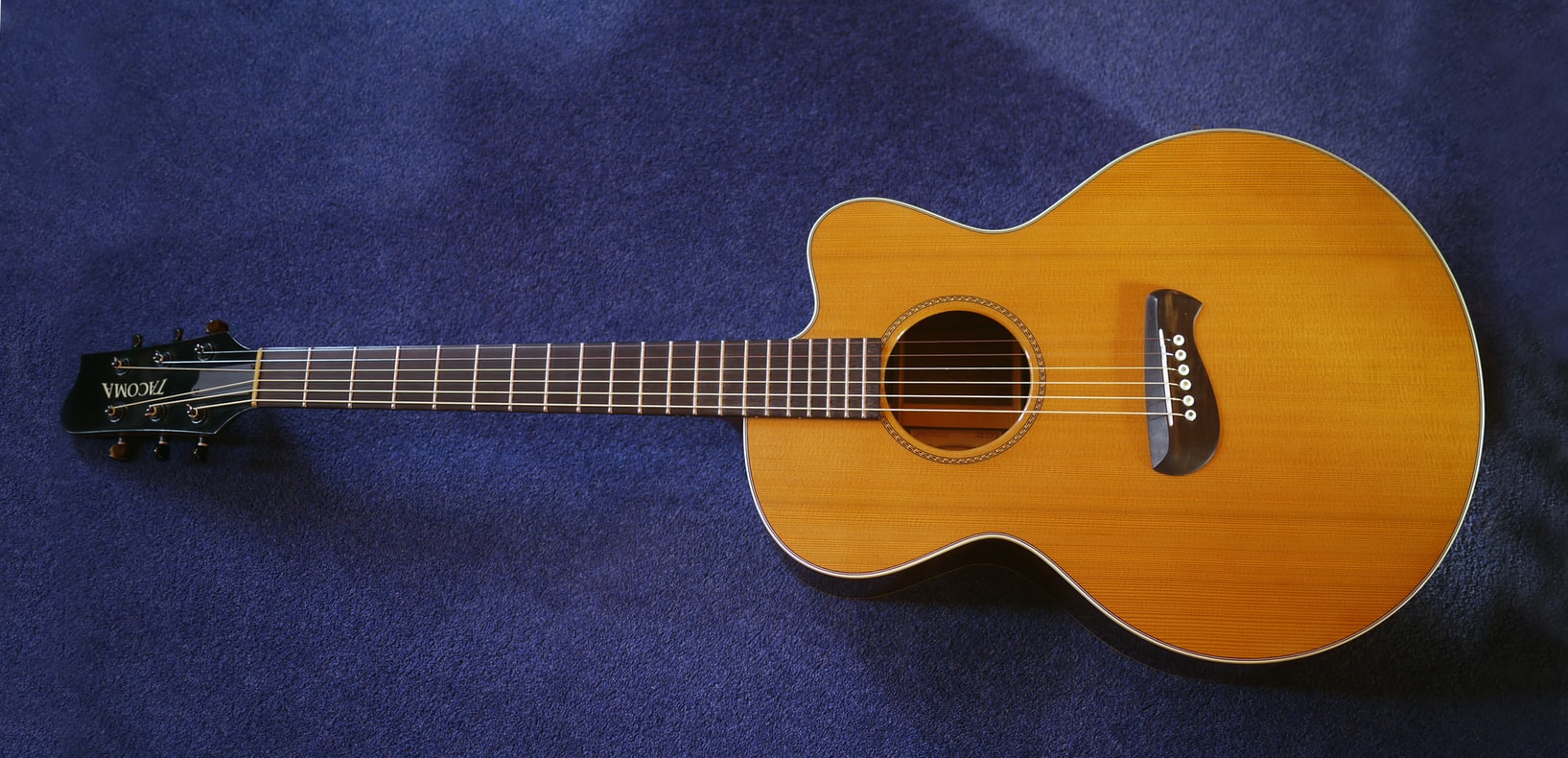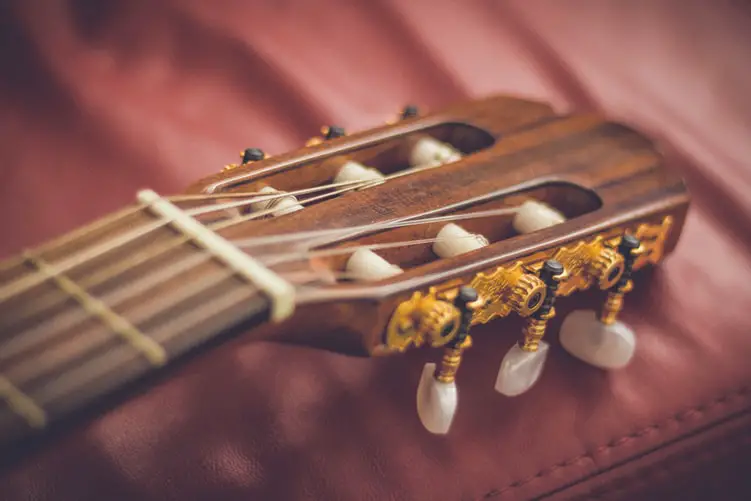As far as the guitar is concerned, the strings need no introduction. They are the core mechanism through which sound is produced. This is regardless of it being an acoustic, electric, or acoustic-electric guitar.
But first things first, what are the kinds of guitar strings?
There are 3 major types of guitar strings. These are the Nylon, Steel, and bronze/brass strings. Other than these major kinds of strings, there are other variants that use these materials.
For instance, this is why the kind of steel-strings used in electric guitars will be different from acoustic guitars. On that note, you should be careful not to use the wrong kind of string on any guitar. This is important in achieving the desired sound output and convenience for the player.
In this article, we are going to do justice to the question of “how to tie guitar strings”. The answers provided will be relevant for both steel and nylon guitars. This is because they are the most popular sort of guitar string used.
So, whichever of these guitars you have in your custody, hoping to tie the strings properly, we have you covered.

What are the parts of the guitar required for attaching and tying the strings?
The parts of the guitar required for attaching and tying the string include the following:
1. The Bridge Pin
2. The Saddle
3. The Nut
4. The Capstan/String Post
5. The Tuning Peg
For the acoustic guitar, the bridge pin is the plastic or wooden lid lifted to allow the strings into the bridge hole. After this is done, it also helps to hold down the string firmly.
The saddle is that part on the bridge that stops the strings from shifting, despite the tension and vibration when it is played. Its narrow pathway ensures that each string stays put.
The Nut also has narrow pathways that restricts the strings from shifting. Unlike the saddle, it is found in between the guitar’s head and fretboard.
Also known as the string post, the capstan has a hole where the string are fitted. As the tuning peg is applied, the capstan begins to turn and tighten the strings.
These are the 5 parts of the guitar required in tying a string.
Table of Contents
Tying Guitar Strings on the Capstan
Why is tying guitar strings on the capstan important?
Properly tying the guitar strings on the capstan is important because it helps to keep the strings well fitted and neat. If the strings are not properly tied, you may have to do them very soon, as they will slip off overtime. Even when the strings are attached firmly, if they are not properly tied, they will not look appealing. You do not want the head of your guitar looking odd, with wrongly tied strings sticking out everywhere.
This is why guitar manufacturers take this subject seriously as seen in every factory-made guitar.
How do you tie guitar strings on a capstan/string post?
To properly tie guitar strings on the capstan or string post, you should do the following:
1. Properly positioning the capstan. The hole of the capstans should be facing each other, perpendicular to the nut and everything beneath it. This way, fitting the strings and eventually tying it will be a lot easier.
2. Fit the string into the capstan’s hole, making it a little bit slack. Rather than making it firm, you can add the string length of 2 or 3 frets to the string. This is leave room for the tuning pegs to fold a handful of strings. Also, the strings should be fixed facing your direction. It should go through the hole inwardly and face your direction afterward.
3. Bend the string backward, fixing it under the other part of the string. While doing this, you should hold down the other end of the string firmly with one hand.
4. After you have fixed the string under the first part of the fitted string, bend it in the reverse position, making it go above the string this time. Do not forget to hold the other part of the string as well.
5. Use your winder to tighten the string.
6. Use a wire cutter to do away with the excess part of the string.
If done properly, you will have yourself a firm and neatly done string. You can be certain you will not be tightening the strings anytime soon. This is except the strings cut off.
Below is a visual illustration of how to go about the whole process.
Video: Tying Guitar Strings
How to Tie Classical Guitar Strings at the Bridge
How do you know it is a classical guitar?
Some of the physical features that will help prove a guitar as classical are listed below.
1. They mostly come with nylon strings.
2. Rather than being fastened with bridge pins, the strings are tied at the bridge end of the guitar.
3. Most classical guitars have a headstock that allows you see through them.
4. Has a slightly shorter neck.
5. They have a slightly wider fingerboard. This is so that players can perform complex finger movements easily.
These are some of the traditional features that indicate a guitar is classical. You should also know this guitar is called the classic or Spanish guitar. So, the next time you hear any of these names used, you already know what it means.
How do you tie a string to a classical guitar’s bridge?
To tie a string to a classical guitar’s bridge, start by inserting the string into the hole beneath the saddle. When the threaded string shows up on the other end of the hole, tie it in a knotted style. To do this, allow about 4 – 6 inches to get to the other end of the hole. Bend it back upward, folding it back into the threaded string twice. Then, draw it firmly as this will ensure it takes the right shape.

If done properly, you can be sure the strings will not slip off at any point.
We suggest that you do not cut off the excess part of the string at this point. This is something you should do after you have sorted out the strings at the headstock.
The subject of tying the strings to the headstock leads us to the next section.
How Do You Tie Guitar Strings at the Headstock?
To tie the guitar strings properly at the headstock,you should do the following:
1. Using the tuning peg, make the capstan face slightly upward.
2. Thread the strings through the hole of the capstan.
3. Bend a short protuded part of the string backward while you hold the other part firmly.
4. In one turn, use the tuning peg to twist the other portion of the string.
5. Afterward, twist the remaining slack part of the string in the other direction.When you are satisfied with the tension, you should have a well tightened guitar string. In tightening the string, turning the tuning peg towards you will loosen the string, while farther away from you will add to the tension.

Below is a video explaining the process.
Video: How to Change Strings on a Classical or Nylon String Guitar
Check out these other in-depth articles…
- How To Restring A Guitar – No Tools Needed
- How To Get Good At Guitar — 13 Tips That’ll Take You From Beginner To Pro
- How Long Does It Take To Learn Bass Guitar?
- How Often To Change Guitar Strings? — It’s Not That Straightforward
- How Much Does It Cost To Restring A Guitar?
- What Notes Are The Guitar Strings? — Detailed Answer
How to Tie Guitar Strings – Related Frequently Asked Questions
What Order Do I String My Guitar?
To string your guitar, it is best to start from the tiniest string, working your way up to the thickest string. This way, you can make sure the string tension is right and without the possibility of breaking. This is especially if you are not willing to tune it the usual E-B-G-D-A-E manner, starting with the 1st string and ending with the 6th string. If you apply too much tension when starting on the 6th and thickest string, you will have to apply more tension than is right for the 1st string. To avoid this, you should start with the 1st string.
However, if you use the E-B-G-D-A-E pattern, then whatever you start with does not really matter.
How Do You String an Acoustic Guitar Without Tools?
To string an acoustic guitar without tools, you should;
- remove the bridge pin;
- align the thick knotted end of the string to the hollow part of the bridge pin. Afterward, fit them into the hole in the guitar’s bridge. You should press down the bridge pin, making sure it is firm enough;
- pass the string tightly across the guitar’s nut. This is the part between the head and the fretboard;
- pass the string through the capstan or string post hole;
- allow the string to be a little loose as you begin to turn the tuning peg from left to right; and
- use a wire cutter to remove the excess part of the string after it is firm enough.
What Key Is A Guitar In?
The keys of the guitar from the 6th string to the 1st string are E-A-D-G-B-E. So, when you tune your guitar, you should do it in this order. This is so that every designated key on the instrument will align with other instruments.
To remember the proper placement of the guitar keys, you can use an acronym. For instance, the acronym “Every-American-Deserves-God’s-Blessing-Everyday” will be immensely helpful. In tuning the guitar, you should be careful not to mistake the 1st string for the 6th one. This is because both strings are tuned to the key E.
Since the guitar is not a transposing instrument like the saxophone, playing along with other instruments will not require counting back or forth.
How Are Guitar Strings Numbered?
The guitar strings are numbered from beneath. The fragile, tiniest, and highest pitch guitar string is referred to as the 1st string. The 2nd string is directly above it and on and on it goes until you get to the 6th string.
Because the 1st and 6th strings are tuned to the same key – Key E, you must be careful not to mistake one for the other. This is especially when you are tuning your guitar strings. On that note, from the 6th string to the 1st string, the natural keys of the guitar strings are E-A-D-G-B-E.
Where Is 0 On A Guitar?
When you play a “0”, you play a semitone before every of the first fret on the fingerboard or fretboard. It will have the same effect as playing the part of the string before the fretboard. Playing 0 on the guitar means playing an open string. This means playing the guitar without placing your fingers on any part of the fretboard.
A large portion of the guitar has a fretboard with various frets. With clear position markers to determine one fret from the other, these frets represent different keys and notes on the guitar. It is not the same situation as with the violin. Although it has a fingerboard that is played, there are no position markers.
What Type of Guitar Strings Should I Use?
You should use a guitar string material that correlates with your guitar. If your guitar is designed for nylon strings, you should not replace it at any point with steel strings. On the other hand, do not use nylon strings on a guitar designed to be used with steel strings.
The side effects of doing this will be heavily felt on the guitar’s head. This is because each kind of string has a weight size that should not be altered. If this is done, it puts more or less than the expected pressure on the guitar’s head.

